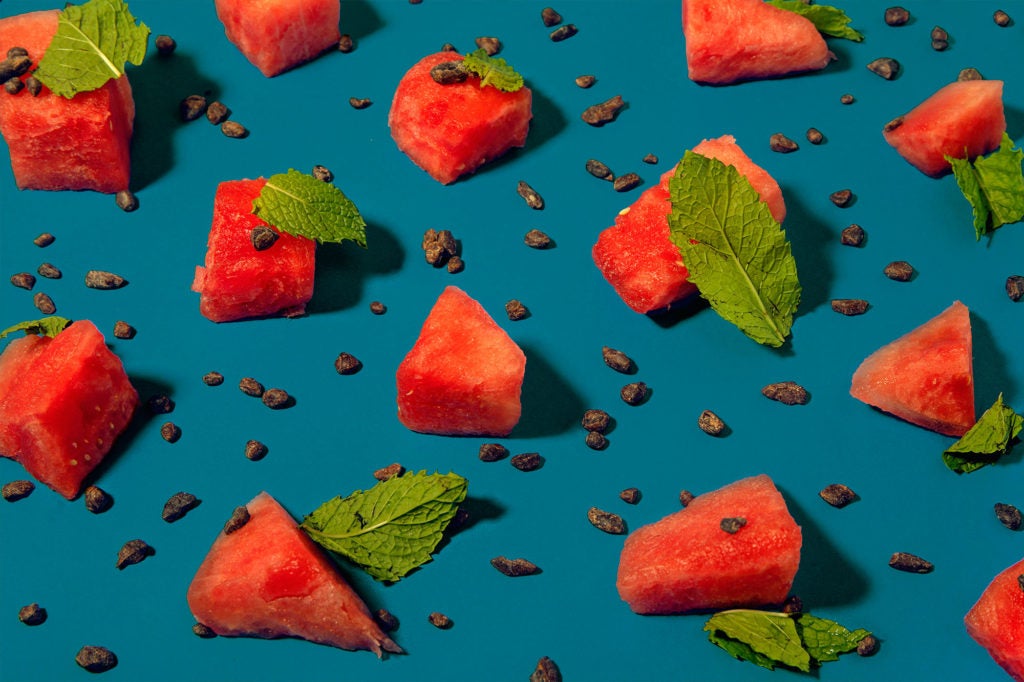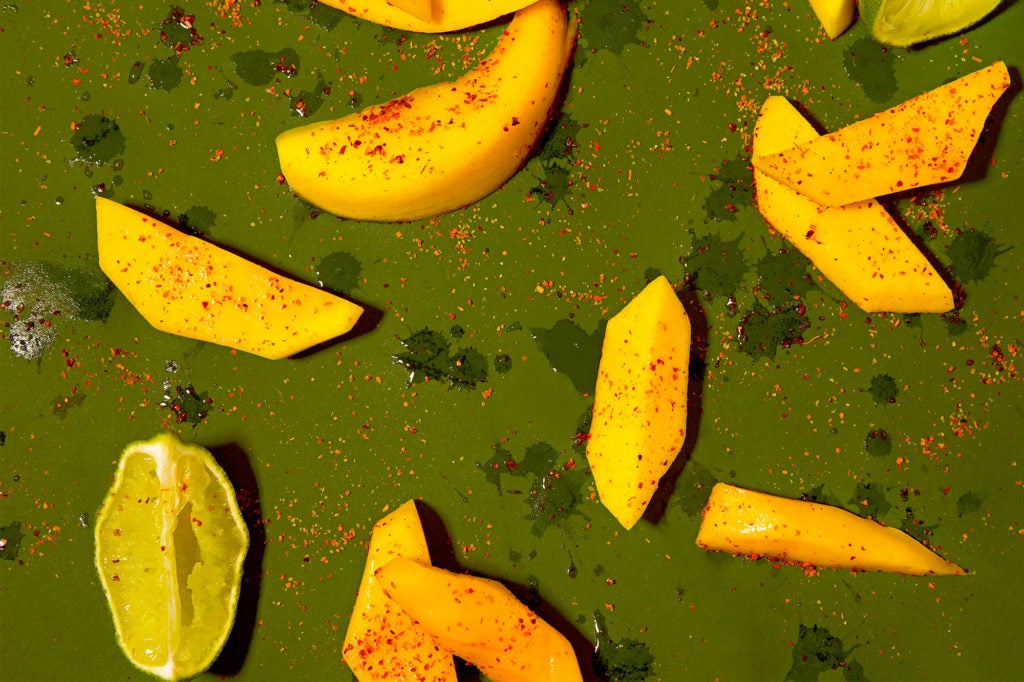
Cocoa nibs, sour cream, and scoops of Tajín will transform bland peaches and underripe melon into something extraordinary.
There’s no substitute for freshly cut, ripe, seasonal fruit from the farmers market, roadside fruit stand, or trusty greengrocer. But life’s reality (work, kids, fantasy football draft prep) keeps us reaching for those handsomely organized rows of perfectly precut cubes and slices available at every supermarket, bodega, Whole Foods, and even the more food-oriented pharmacy chains, like CVS. This move is no doubt a steep step up from the saccharine sweet cans of shelf-stable fruit cocktail that kept our parents from scurvy, but more often than not, the contents of the plastic clamshells packed with underripe honeydew and mealy pineapple fail to meet our expectations.
We can blame (or be thankful for) modern industrial farming practices and hyperefficient transportation systems for bringing the farm stand to our doorstep with astonishing proficiency. California strawberries can be washed, cooled, cut, packaged, shipped, and presented at Walgreens in Hoboken a mere 72 hours after harvest. At this rapid distro speed, much of their quality is locked in. But the farmers are forced to sacrifice planting the sweetest varietals for transport-hearty options and forced to pick them early to ripen en route, forgoing flavor for texture and presentation.
Past generations weren’t so lucky: Fresh fruit was harder to come by, the quality low. To help make it taste better, people often seasoned their fruit with sugar and even artificial sweeteners like Sweet’N Low to offset underripeness, or added herbs and spices to cover for the lack of natural quality.
Today, the practice has fallen from fancy, but the techniques can still be applied to that underwhelming bag of peaches, giving them a surprisingly helpful boost. The method is simple to execute and effective, provided you understand some basic principles of taste. Most important: palate fatigue and the counterintuitive way our taste baseline shifts as we eat. The idea here is that our taste buds become overwhelmed, and eventually desensitized, as we eat a meal, so the perceived sweet, sour, salt, or bitterness becomes less and less apparent to the tongue. The way to fix the problem is by clearing or resetting our palate. We all know the sour outcome of drinking a glass of orange juice after brushing our teeth. But squeeze some lemon on your tongue before the same glass, and your OJ will taste impossibly sweet.

Applying the same principle to cut fruit works wonders. Squeeze some lime juice over your cantaloupe, and the first thing your tongue tastes is sour, but it transitions to an amplified natural sweetness of the muskmelon jumping out with every bite. Bland strawberries can spring to life with a sprinkle of sugar to help highlight their underlying acidity. Once you’re familiar with the basic principles, you can delve deeper, adding herbs, spices, and other ingredients. Bitter, crunchy, and chocolaty cocoa nibs can resurrect overripe and mealy watermelon, adding texture and uncovering the fruit’s natural sweetness while complimenting its flavor with a classic Sicilian pairing. Black pepper on orange, tarragon on grapefruit, chile powder on mango, cinnamon on pears—the list goes on and on.
Here are a few simple recipes to get you going, but don’t be afraid to experiment with other combinations once you’re comfortable. The best advice I have is to start with fewer ingredients so you’re able to clearly taste the pairing. If you overcomplicate things, it can be difficult to tell what’s adding value and what’s getting in the way.
Peaches with honey, lemon, and sour cream
The trick to honeyed peaches is warming your honey so that it’s thin enough to drizzle from a spoon. Rest your sealed honey jar in a bowl of hot water or microwave it for a few seconds to thin the nectar. Mix your sliced peaches with a few dollops of sour cream thinned with lemon juice for extra acidity (yogurt works marvelously as well), then drizzle with a thin stream of golden honey to achieve your desired sweetness.
Honeydew and cantaloupe with basil and feta cheese
As a kid I would order a half cantaloupe filled with cottage cheese as an after-school snack at the Greek diner down my block. It may seem like a strange combination, but melons are in the gourd family, closely related to squash and cucumbers, which also pair really well with rich, salty cheeses and meats (think melon and prosciutto). Feta is the perfect option when you’re on the go, precrumbled and packed full of salty, rich flavor. Combined with basil, which adds a spicy floral kick, the pairing can bring joy to the saddest of fruit. It’s as easy as tearing some basil leaves and tossing them along with some cheese crumbles in your clamshell and giving it a shake.

Mango with Tajín and lime
Tajín is fruit salad’s silver bullet. Consisting of salt, dehydrated lime, and mild chile powder, the mixture has everything you need to take just about any fruit and explode the flavor. Take sliced mango and toss with lime juice to help adhere the spice, then shake a healthy dusting of Tajín over your fruits, and you’ll instantly be transported to the beaches of Jalisco. You can buy it online here.
Oranges with tarragon, black pepper, and salt
This may seem like a snooty and chef-y combination, but there’s something about the combination of the licorice-y tarragon and subtle bitter spice of black pepper that can wake any citrus from the dead. A healthy sprinkle of freshly cracked black pepper, a few tarragon leaves, and a pinch of salt is all you need to amplify orange wedges or peeled half-round slices.
Cinnamon apples
Classic, classic, classic. In my house, we had a shaker filed with three parts sugar, one part cinnamon, and a pinch of kosher salt. My mother’s recipe calls for thinly sliced seedless apple wedges, the tarter the better (think Granny Smith). A few drops of lemon juice to help adhere the spice, then a generous dusting of cinnamon and sugar is all that’s needed to transform a mealy apple into something special.
Watermelon with cocoa nibs and mint
Cocoa nibs are insanely bitter, so be mindful not to overdo it. The goal is to have a heavily watermelon-rich ratio (lots of watermelon) with just a few crispy, crunchy, bitter bites to help highlight the melon’s sweetness. Tear the mint leaves into smaller pieces so you’re not overwhelmed by their flavor, and add a pinch of salt to help marry the combination.